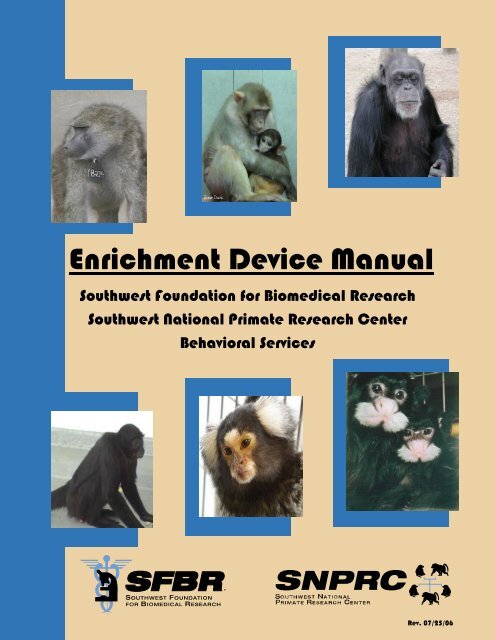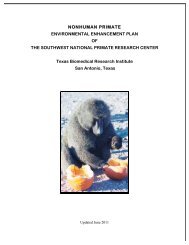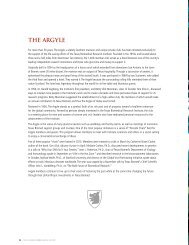Enrichment Device Manual - Texas Biomedical Research Institute
Enrichment Device Manual - Texas Biomedical Research Institute
Enrichment Device Manual - Texas Biomedical Research Institute
- No tags were found...
You also want an ePaper? Increase the reach of your titles
YUMPU automatically turns print PDFs into web optimized ePapers that Google loves.
<strong>Enrichment</strong> <strong>Device</strong> <strong>Manual</strong>Southwest Foundation for <strong>Biomedical</strong> <strong>Research</strong>Southwest National Primate <strong>Research</strong> CenterBehavioral ServicesRev. 07/25/06
For more information on this manual contact:Steven IredaleSouthwest Foundation for <strong>Biomedical</strong> <strong>Research</strong>Southwest National Primate <strong>Research</strong> CenterBehavioral ServicesP.O. Box 760549San Antonio, <strong>Texas</strong> 78245-0549(210) 258-9832siredale@sfbr.org
Table of Contents 1Preface.............................................................................................................................................3Non-Food <strong>Device</strong>s...........................................................................................................................4Triangle and Ring Rattles .......................................................................................................5Mirror......................................................................................................................................6Kong on Chain ........................................................................................................................7PVC on Chain .........................................................................................................................9PVC Rattle ............................................................................................................................11Toys on Chain.......................................................................................................................13Nylabone on Chain ...............................................................................................................15Food <strong>Device</strong>s.................................................................................................................................17Feeder Mix............................................................................................................................18Cup Feeder (Large and Small)..............................................................................................19Banana Feeder (Large and Small).........................................................................................21Puzzle Feeder........................................................................................................................23Three Ring Feeder.................................................................................................................25Pump Feeder .........................................................................................................................27Paint Roller ...........................................................................................................................29Foraging Board .....................................................................................................................32Grooming Board ...................................................................................................................34Kong Feeder..........................................................................................................................36Tube Feeders.........................................................................................................................37
Table of Contents 2Puzzle Ball ............................................................................................................................38Raisin Board..........................................................................................................................40Bleach Bottle Feeder.............................................................................................................42Fruit on Chain .......................................................................................................................44Termite Mound .....................................................................................................................46Pipe Feeder............................................................................................................................49Peanut Cart............................................................................................................................51Appendix.......................................................................................................................................54Environmental <strong>Enrichment</strong> Data Sheet.....................................................................................55
Preface 3The following manual is a compilation of enrichment devices used at SouthwestFoundation for <strong>Biomedical</strong> <strong>Research</strong>. With over 6,000 non-human primates housed at thisfacility, it is cost-prohibitive to purchase all of the devices needed to meet our enrichment needs.We have found it easier and more cost-effective to build devices out of material that is availablefrom most hardware stores. With a little creativity and some tools we have been able tosuccessfully design, build, and implement several devices.The description of each device includes the objective, pros and cons, how to make it,materials and cost, how to use the device, and the species and housing type for which it isprimarily used. Although these devices are designed for baboons, macaques, and chimpanzees,the primary species housed at this facility, they can be used for other species as well. Only a fewmethods of implementing the devices are given; there are numerous ways to implement eachdevice, so be creative. The device designs in this manual may not work at all facilities so somemodifications may be needed. This manual is a foundation to help you get started; yourcreativity and the restrictions of your facility are the only limits to how far these devices can go.A sample of a filled-out data sheet is provided to give ideas to help keep records.All devices in this manual are designed to provide high-quality enrichment for nonhumanprimates in a manner that is safe for the animals. However, it is important to remember that theimproper use of any enrichment device could potentially cause injury or even death, so we urgeyou to follow safety precautions carefully. We are constantly designing and building newdevices, as well as making changes to existing ones, so this manual will be updated from time totime to show what has been added or changed. We hope you find this manual helpful and usefulwhen looking for enrichment ideas.
Non-Food<strong>Device</strong>s4
Non-Food <strong>Device</strong>s 5Triangle and Ring RattlesPhoto courtesy of Bio-servDescription: The devices consist of a stainless steel rod in the shape of a triangle or ring. Threewashers run along the rod which the animals can manipulate and rattle to make noise. The rodruns through a chain that is connected to a snap hook which is used to connect the device to theoutside of the cage.Objective: These devices provide the animal with manipulable enrichment.Housing Type and Species: These devices can be used in all housing environments for allspecies.<strong>Enrichment</strong> Category: PhysicalPros: The devices are made of stainless steel, making them very durable and easy to clean.Cons: These enrichment devices must be purchased, because they are difficult to make. Thisrequires purchasing new devices when existing devices are lost or broken.Instructions to Make: These devices are purchased from an enrichment device company.Materials and Cost:To purchase-1. $8.50- $8.75 each (Bio-serv)Instructions to Use: Clip these devices to the outside of the cage where they are easilyaccessible by the animal. They can be left on the cage for 2-7 days. Optimally, these devicesshould be used in rotation with other devices to maintain novelty.
Non-Food <strong>Device</strong>s 6MirrorPhotos courtesy of Bio-servDescription: This device is a sheet of stainless steel cut into a circle 6” in diameter. A hole ispunched along the edge and a twist clip connects the mirror to a chain. The chain is attached to asnap hook at the other end that allows the device to be clipped to the outside of the cage.Objective: The device provides the animal with manipulable and sensory enrichment. It isextremely useful during the rare occasions that a singly housed primate has no contact with aconspecific.Housing Type and Species: This device can be used in all housing environments for all species.<strong>Enrichment</strong> Category: PhysicalPros: The device is made of stainless steel, making it very durable and easy to clean.Cons: This device must be purchased and is relatively expensive. Although it is quite durable, itis not indestructible, and does eventually require replacement. Also, the device requirespolishing to remove lime scale build-up so that the animals are able to see themselves.Instructions to Make: This device is purchased from an enrichment device company.Materials and Cost:To purchase-1. $14.00- $14.75 each (Bio-serv)Instructions to Use: The device is clipped on the outside of the cage where it is easily accessibleby the animal. It can be left on for 2-7 days. Optimally, this device should be used in rotationwith other devices to maintain novelty.
Non-Food <strong>Device</strong>s 7Kong on ChainPhoto courtesy of Bio-servDescription: This device is made of a virtually indestructible type of rubber. It comes in manyshapes, although the most commonly seen is the shape of three hollow balls fixed together. Achain with a snap hook is attached in the top center of the device to allow the device to beclipped to the outside of the cage.Objective: The device provides the animal with manipulable enrichment.Housing Type and Species: This device can be used in all housing environments for all species.<strong>Enrichment</strong> Category: PhysicalPros: The device is made of hard rubber, making it durable and easy to clean. The device can beused as a food or non-food enrichment device.Cons: The device is made of hard rubber, and the animals will be able to chew on it and caningest the material. However, it will not cause any gastrointestinal complications. Somesanitizing agents can break down the material (Enviro-B, etc.).Instructions to Make:1. Cut a length of 2/0 straight link coil chain 6-8 links long with the bolt cutters. Cutchain shorter if device is to be hung inside of cage. The shorter chain will helpprevent injury or death.2. Depending on size of Kong (4” for monkeys, 6” for chimpanzees) take a 5/16” or3/8” washer and slide it down onto a 5/16”x 1” or 3/8”x 1 bolt respectively.3. Insert the bolt into the base of the Kong toy and push it through the hole at the top.4. With the threaded end now poking through the top of the Kong, slide the end link ofchain down over the bolt. If using the 3/8” bolt for 6” Kong, expand link bysqueezing in a vise.5. Slide another 5/16” or 3/8’ washer down onto the bolt over the chain.
Non-Food <strong>Device</strong>s 86. Thread a 5/16” or 3/8” locking nut onto the bolt.7. Attach a 6” extension to a ratchet followed by a 1/2” or 9/16” socket.8. Insert the 1/2” or 9/16” socket into the base of the Kong and place it securely on thehead of the bolt.9. Holding the head of the bolt with the ratchet, use a 1/2” or 3/8” wrench to tighten thelocking nut down securely.10. Slide a snap hook into the end link of chain hanging from the bolt.11. Secure snap hook to the chain squeezing in a vise.Materials and Cost:To purchase-1. Large 4” with chain: $15.50-$16.50 each (Bio-serv)2. X-large 5” with chain: $17.75-$19.25 each (Bio-serv)To make-1. Kong: $5.45- $6.05 each (Bio-serv)2. Chain: $1.55/ft (Alamo Iron Works)3. Snap hooks: $2.27 each (Alamo Iron Works)Total: Less than $10Instructions to Use: Clip the device on the outside of the cage where it is easily accessible bythe animal. It can be left on for 2-7 days. Optimally, this device should be used in rotation withother devices to maintain novelty.
Non-Food <strong>Device</strong>s 9PVC on ChainDescription: This device consists of one to three pieces of PVC (usually a 45° or 90° elbow, acoupling, or a combination of the three.) A chain is run through the piece(s) of PVC and thenconnected to itself end to end by a snap hook.Objective: The device provides the animal with manipulable enrichment.Housing Type and Species: This device can be used in all housing environments for all species.<strong>Enrichment</strong> Category: Physical, (if used with treats occupational, nutritional)Pros: The device is cheap and easy to make, as well as easy to clean. The device is primarilyused as a non-food device. If desired, treats can be placed inside the pieces of PVC to make afood device.Cons: Although this device can be used as a feeding device it does not encourage long bouts offoraging.Instructions to Make:1. Cut a piece of 2/0 straight link coil chain 6” long with bolt cutters. If device is to behung on inside of cage do not make chain any longer. The shorter chain will helpprevent injury or death.2. Run the chain through 1-3 1” PVC fittings.3. After chain is through all the pieces connect the two ends of the chain together with asnap hook.4. Secure the snap hook by squeezing it in a vise.
Non-Food <strong>Device</strong>s 10Materials and Cost:To make-1. PVC: $.29-$.55 each (Alamo Iron Works)2. Chain: $1.55/ft (Alamo Iron Works)3. Snap hooks: $2.27 each (Alamo Iron Works)Total: Less than $10Instructions to Use: Clip the device to the outside of the cage where the animal can easilyaccess it. If used to deliver treats, the treat should be placed inside one of the pieces of PVC, sothat it does not easily fall out but the animal is able to access it. This device can be left on for 2-7 days. Optimally, this device should be used in rotation with other devices to maintain novelty.
Non-Food <strong>Device</strong>s 11PVC RattleDescription: This device consists of two PVC slip caps with a 2-3” piece of PVC connectingthem. A bolt runs through the device from slip cap to slip cap and has a chain and snap hook atone end to hang the device. Washer and nuts run along the bolt to generate noise.Objective: The device provides the animal with manipulable enrichment.Housing Type and Species: This device can be used in all housing environments for all species.<strong>Enrichment</strong> Category: PhysicalPros: The materials used to make this device are durable and cheap, as well as easy to clean. Ifthe animal breaks the PVC, the nuts and washer will remain on the bolt so the animal will not beable to grab and possibly ingest them.Cons: The device does not make much noise and is not reflective or shiny, so it does not presentmuch opportunity for different types of enrichment.Instructions to Make:1. Using a hacksaw, cut a piece of PVC pipe (any diameter is fine) to a length of 2-3”.2. Insert a 5/16” drill bit into a power drill and secure.3. Drill a 5/16” hole in two slip caps of the appropriate diameter for the PVC pipe used.4. Run a 5/16”x 5” bolt through a 5/16” flat washer. Run the bolt and washer throughthe hole in one of the caps.5. Apply PVC primer to the first 1/2” of one end of the pipe as well as the inside of theslip cap with the bolt through it. After the primer has dried, apply PVC glue to thesame areas. After glue has been applied, slide the slip cap with the bolt through itonto the end of the pipe.6. Place 3-5 washers and large nuts onto the bolt.7. Using step 5, glue the remaining slip cap to the other end of the pipe so that the boltprotrudes through the hole drilled in step 3.
Non-Food <strong>Device</strong>s 128. Using bolt cutters, cut a piece of 2/0 straight link coil chain 6-8 links long. Cut chainshorter if device is to be hung on inside of cage. The shorter chain will help preventinjury or death.9. Slide the piece of chain onto bolt followed by a 5/16” flat washer. Thread a 5/16”lock nut onto the bolt.10. Place a 1/2” socket onto a ratchet. Using the socket and ratchet and a 1/2” box endwrench tighten lock nut until secure.11. Place a snap hook on the trailing end link of the chain.12. Secure the snap hook to the chain by squeezing in a vise.Materials and Cost:To make-1. PVC: Varies on size used2. Chain: $1.55/ft (Alamo Iron Works)3. Bolt: $15.98 per 100 (Alamo Iron Works)4. Washers: $2.39/lb (Alamo Iron Works)5. Lock nut: $6.95 per 100 (Alamo Iron Works)6. Snap hook: $2.27 each (Alamo Iron Works)Total: Less than $10Instructions to Use: To use this device simply hang on the cage where it is easily accessible bythe animal. This device can be used for 1-7 days. Optimally, this device should be used inrotation with other devices to maintain novelty.
Non-Food <strong>Device</strong>s 13Toys on ChainDescription: This device is made of varying toys running along a chain. The chain is connectedto itself end to end by a snap hook. Any type of toy can be used, but rubber or Kong toys aresuggested.Objective: This device provides the animal with manipulable enrichment.Housing Type and Species: This device can be used in all housing environments for all species.<strong>Enrichment</strong> Category: Physical (if used with treats, occupational, nutritional)Pros: This device offers variety to the animal. The device is also easy to clean. Depending ontoys used, treats can be added to promote foraging behavior.Cons: The chain tends to be longer for this device compared to others, requiring added care toensure safe use. Note that the longer chain could cause injury or death if the device is hunginside or if the animal can get the device inside the cage.Instructions to Make:1. Using bolt cutter, cut a piece of 2/0 straight link coil chain to a length of two feet.Cut chain shorter if device is to be hung inside the cage. The shorter chain will helpprevent injury to the animal.2. Run chain through selected toys.3. Place both end links of the chain with a snap hook.4. Secure snap hook to the chain by squeezing in a vise.Materials and Cost:To make-1. Chain: $1.55/ft (Alamo Iron Works)2. Snap hook: $2.27 each (Alamo Iron Works)3. Toys: VariesTotal: $10-$12
Non-Food <strong>Device</strong>s 14Instructions to Use: Hang device on cage where it is easily accessible by the animal. Thisdevice can be used for 1-7 days. Optimally, this device should be used in rotation with otherdevices to maintain novelty.
Non-Food <strong>Device</strong>s 15Nylabone on ChainDescription: This device is a Nylabone toy with a chain and snap hook bolted to it to enable it tobe hung on a cage.Objective: This device provides the animal with manipulable enrichment.Housing Type and Species: This device can be used in all housing environments for all species.<strong>Enrichment</strong> Category: PhysicalPros: This device is cheap and easy to make and clean.Cons: Depending on cage type, animals can pull toys through the bars. If toy is pulledcompletely in, it can be difficult to remove.Instructions to Make:1. Acquire a Nylabone toy.2. Insert a 5/16” drill bit into a power drill and secure.3. Drill a 5/16” hole at one end of the Nylabone.4. Using bolt cutters, cut a piece of 2/0 straight link coil chain 6-8 links long. Cut chainshorter if to be hung on inside of cage. The shorter chain will help prevent injury ordeath.5. Run a 5/16” washer onto a 5/16” x 1 1/2" bolt.6. Run bolt with washer through hole in the Nylabone.7. Place one of the end links of the chain onto the bolt followed by a 5/16” washer.8. Thread a 5/16” lock nut onto bolt.9. Attach a 1/2" socket to a ratchet.10. Place socket on the head of the bolt and a 1/2” wrench onto the lock nut and tightenuntil secure.11. Place a snap hook into the trailing end link of chain.12. Secure snap hook to chain by squeezing in a vise.
Non-Food <strong>Device</strong>s 16Materials and Cost:To make-1. Nylabones: $2.69- $5.28 each (Petedge)2. Chain: $1.55/ft (Alamo Iron Works)3. Snap hook: $2.27 each (Alamo Iron Works)Total: Less than $10Instructions to Use: Hang device on cage where it is easily accessible by the animal. Thisdevice can be used for 1-7 days. Optimally, this device should be used in rotation with otherdevices to maintain novelty.
Food <strong>Device</strong>s17
Food <strong>Device</strong>s 18Feeder MixFeeder mix is a staple food item used in conjunction with a lot of the food devices in this manual.This manual includes instructions on how we make our basic feeder mix, but your imagination isthe limit, as long as it falls within the guidelines of your facility. We mix and store ours in a 33gallon Rubbermaid container, but you should mix and store yours according to your facility’sguidelines and usage.Instructions to Make: (Always wear exam gloves when preparing food)1. Pour 2 large bags of Cheerios, Honey Nut Cheerios, Granola w/raisins, and Chexcereal into a 33 gallon Rubbermaid container.2. Pour 2 large scoops of sunflower seeds and pigeon seed into the container.3. Thoroughly mix items with scoop or hands.4. Repeat steps 1-3 until container is full.5. Whenever making a new batch, pour remainder of old mix into a separate container.After filling container, pour old mix on top to enable it to be used first.
Food <strong>Device</strong>s 19Cup Feeder (Small and Large)Description: The device consists of four to five PVC slip caps, all facing the same way (1” capsfor small and 2” caps for large), that run along a 3/8”x 12” bolt. The slip caps are filled withfood items such as feeder mix, fruit, etc. A chain and snap hook is attached to the top of the boltto enable the device to be hung onto the cage. Large washers can be inserted (optional) betweeneach cap to divide the slip caps and act as covers, making the food inside the cups more difficultto obtain.Objective: This device provides occupational and nutritional enrichment and encouragesspecies-typical behavior, particularly long bouts of foraging and object manipulation.Housing Type and Species: The small version of this device can be used for single- or pairhousedmacaque species, and young baboons (infants or juveniles), while the larger version canbe used for single- or pair-housed adult baboons and chimpanzees.<strong>Enrichment</strong> Category: Physical, occupational, nutritionalPros: These devices are easy to make, prepare, and clean. These devices provide occupationaland nutritional enrichment for the animal, thereby encouraging lengthy bouts of foragingbehavior.Cons: Due to the device’s simplicity, it is used best by the animal as a novelty item. When ananimal is exposed to the device too often or for a lengthy period of time, it will becomeproficient at manipulating the device to retrieve forage. Future exposure to the device will not beas enriching for the animal as it loses its novelty and challenge.Instructions to Make: (washers optional)1. Insert a 3/8” bit into the drill press and tighten using the chuck key.2. Drill a 3/8” hole through the center of the bottom of four to five 1” PVC (smallversion) or 2” PVC (large version) slip caps.3. String each of the cups down onto the 3/8” x 12” hex head bolt.4. Screw a standard 3/8” nut down to the point where the thread ends on the bolt.
Food <strong>Device</strong>s 205. Cut a length of 2/0 straight link coil chain 6-8 links long with the bolt cutters.6. Using a vise, squeeze the end link until it opens just enough to allow the 3/8” bolt topass through.7. Slide a 3/8” washer down onto the nut that was previously screwed onto the bolt.8. Slide the expanded link of chain down onto the bolt.9. Slide another 3/8” washer down over the chain.10. Thread a 3/8” lock nut down onto the assembled piece.11. Attach a 9/16” socket to a ratchet.12. Using the socket to hold the head of the bolt, tighten the nut down using a 9/16”wrench.13. With the nuts secured, slide a snap hook into the end link of chain hanging from thebolt.14. Secure the snap hook to the chain by squeezing in the vise.Materials and Cost:To make-1. PVC caps:$0 .55 each (small) and $1.77 each (large) (Alamo Iron Works)2. Bolt: $0.90 each (Ace Bolt and Screw)3. Lock nuts: $5.39 per 100 (Alamo Iron Works)4. Flat washers: $4.24/lb (Alamo Iron Works)5. Snap hook: $2.27 each (Alamo Iron Works)6. Chain: $1.55/ft (Alamo Iron Works)Total: Less than $10Instructions to Use: Fill the cups with feeder mix (see Feeder Mix) or similar food item. Clipthe device to the outside of the cage where it is easily accessible by the animal. The items usedcan be frozen to increase time used and make food more challenging to extract. This device canbe left on the cage for 2-7 days. Optimally, this device should be used in rotation with otherdevices to maintain novelty.
Food <strong>Device</strong>s 21Banana Feeder (Small and Large)Description: The device consists of a 10” long piece of PVC pipe (1” diameter for small and 2”diameter for large). Bananas or other produce are placed into the pipe. A chain with snap hooksis bolted to each end of the pipe to hang the device on the cage. Four to five holes are drilledinto the pipe (3/4” for small and 1” for large). They are used by the animal to dig out food.Objective: This device provides the animal with occupational and nutritional enrichment, andencourages species-typical behavior, particularly long bouts of foraging and object manipulation.When the food is frozen, this device also serves as a type of sensory enrichment.Housing Type and Species: The small version of this device can be used for single- or pairhousedmacaque and baboon species, while the larger version can be used for single- or pairhousedchimpanzees.<strong>Enrichment</strong> Category: Physical, occupational, nutritional, sensory (if frozen)Pros: These devices are easy to make, prepare, and clean.Cons: If left up for too long, these devices can become unsanitary. The holes on the device mustalso be big enough so that the animals cannot get their fingers stuck in the device. These devicesalso require a long narrow brush to clean the insides thoroughly.Instructions to Make:1. Cut a piece of PVC pipe 10” long with a hack saw (1” diameter for small and 2”diameter for large).2. Cut 2 lengths of 2/0 straight link coil chain 6-8 links long with the bolt cutters.3. Using the vise, squeeze the end links of both pieces of chain until they open justenough to allow a 3/8” bolt to pass through. Set the chain aside.4. Insert a 3/8” drill bit into the drill press and secure using the chuck key. A hand-helddrill can be used by first securing the pipe in a vise before drilling.
Food <strong>Device</strong>s 225. One and a half inches from one end of the PVC pipe, drill a hole straight through, sothat the drill bit comes out the other side. A 3/8” bolt of appropriate length shouldnow be able to pass all the way through the PVC pipe, straight through the holes.6. Repeat this step at the other end of the PVC pipe. Make sure that the set of holes runsthe same way as the set that was previously drilled.7. Remove the 3/8” bit and replace it with a Unibit.8. Using the Unibit, drill four holes randomly along the PVC pipe. (3/4” diameter forsmall and 1” diameter for large)9. Place 3/8” bolts of appropriate length through the holes on both ends. After bolts arethrough the pipe slide 3/8” washers onto them.10. Using the links expanded in the vise, slide each one onto a bolt, followed by another3/8” washer.11. Thread a 3/8” lock nut onto each bolt.12. Attach a 9/16” socket to a ratchet.13. Using a 9/16” wrench to hold the head of the bolt, tighten the nut down using the9/16” socket.14. With the nuts secure, slide a snap hook into the trailing end of chain hanging fromeach bolt.15. Secure the snap hook by squeezing it in the vise.Materials and Cost:To make-1. PVC: $4.90 per 20 ft (Alamo Iron Works)2. Bolts: $8.09 per 100 (Alamo Iron Works)3. Lock nuts: $5.39 per 100 (Alamo Iron Works)4. Flat washers: $4.24/lb (Alamo Iron Works)5. Snap hook: $2.27 each (Alamo Iron Works6. Chain: $1.55/ft (Alamo Iron Works)Total: Less than $10Instructions to Use: To prepare the device for use, slide a banana (or other produce) into thepipe through one end. Two bananas may be used in the large version. After the banana(s) is(are) in, place in the freezer until banana is completely frozen. Freezing items is optional butdoes make device more challenging as well as providing sensory enrichment. When banana isfrozen, remove from freezer and clip both chains on the cage in a place easily accessible by theanimal so that the feeder itself is hanging horizontally with holes facing the animal. This devicecan be left on the cage for 1-2 days. Optimally, this device should be used in rotation with otherdevices to maintain novelty.
Food <strong>Device</strong>s 23Puzzle FeederDescription: The device consists of three 12” long pieces of 1” diameter PVC. Peanuts or otherlarge foods are placed in the pipes. These pipes are bolted together using a 5/16”X 8” bolt onboth ends. There are pieces of chain at each end of the bolt (four pieces total). There are 1/2”holes drilled 1” apart along the three pipes with a 1” long by 3/4” hole drilled on the edge of oneouter pipe and on the face of the other outer pipe.Objective: This device provides the animal with occupational and nutritional enrichment andencourages species-typical behavior, particularly long bouts of foraging and object manipulation.Housing Type and Species: The device can be used for used for single- or pair-housed macaqueand baboon species.<strong>Enrichment</strong> Category: Physical, occupational, nutritionalPros: The device is more complex to solve than other feeders, so it will make the animal workharder and longer to extract food. This extra work will keep the animal occupied longer,encouraging a higher frequency of normal behavior. This device is also relatively easy to clean.Cons: The best way to use the device is to fill it with peanuts or other large objects. Grain suchas pigeon seed is too small and falls out. This is both wasteful and requires little effort from theanimal to obtain food. Also, this device is large and bulky and requires large amounts of roomfor storage, transportation, and cleaning, if using a dishwasher.Instructions to Make:1. Cut three pieces of 2” PVC pipe 12” long.2. Cut six pieces of 1/2” PVC 1” long.3. Cut four pieces of trade size 4, twist link chain 6-8” long.4. Insert a 5/16” drill bit into a power drill and secure. Using the drill, drill a holecompletely through the three pieces of pipe at both ends. When set next to eachother, the holes on all three pipes should line up.
Food <strong>Device</strong>s 245. Run a 5/16”x 7” bolt through a 5/16” flat washer and the end link on one of the piecesof chain.6. Insert the bolt into the first hole at one end of a pipe. Now place one of the pieces of1/2” pipe on the end of the bolt and then push bolt through the next hole.7. Repeat steps 5 & 6 for the two remaining pipes.8. When the bolt is through all three pipes, run another piece of chain on the boltthrough an end link. After that, thread on a 5/16” flat washer. Finally, thread a 5/16”lock nut onto the end of the bolt.9. Attach a 1/2” socket to a ratchet.10. Place a 1/2" wrench on the head of the bolt. Using the 1/2” socket, tighten the locknut down until secure.11. Repeat steps 5-10 for the holes on the other end of the pipes.12. Finally, using the end link of the four chains, run the hook end of snap hooks throughthe chain.13. Secure the snap hooks by squeezing in a vise.14. Using a 1/2” bit and a power drill, drill 6, 1/4” holes on the same side of all threepipes so that there is an inch of space in between them and a 1/2” space from the lasthole to the end of the pipe.15. On one of the outside pipes take a 1/4” router bit and router out the last hole on oneend to make an oval 1/4” wide by 1/2” long.16. On the other outer pipe at the opposite end of where the last oval was made, makeanother 1/4” by 1/2” oval on the side of the pipe.Materials and Cost:To make-1. PVC: 2”-$30.29 per 20 ft (Alamo Iron Works)2. PVC: 1/2”-$7.76 per 20 ft (Alamo Iron Works)3. Bolts: $21.39 per 50 (Alamo Iron Works)4. Chain: $1.55/ft (Alamo Iron Works)5. Flat washers: $4.24/lb (Alamo Iron Works)6. Lock nuts: $5.39 per 100 (Alamo Iron Works)7. Snap hooks: $2.27 each (Alamo Iron Works)Total: Less than $10Instructions to Use: This device is best used with larger food items such as peanuts so that theitems do not fall out if the animal shakes the device. Small seeds and other foods are easilyspilled out, giving little possibility for the animal to work for it. Small food items also create amess. Fill the device with the desired food item by using the oval hole cut at the ends of theouter pipes. After the device is filled, hang it on the cage using the four chains so that the ovalon the side of the outer pipe is over the feed hopper and the string of holes along the front arefacing the animal. This device can be left on the cage for 2-7 days. Optimally, this deviceshould be used in rotation with other devices to maintain novelty.
Food <strong>Device</strong>s 25Three Ring FeederDescription: The device consists of a 1½” PVC pipe with a slip cap on one end and a screw capon the other end with three 1¼” long pieces of 2” PVC running along it. Four holes along thepipe allow the animal to access the food. Chains with snap hooks at each end enable the deviceto be hung on the cage.Objective: This device provides the animal with occupational and nutritional enrichment andencourages species-typical behavior, particularly long bouts of foraging and object manipulation.Housing Type and Species: This device can be used for single- or pair-housed macaque andbaboon species.<strong>Enrichment</strong> Category: Physical, occupational, nutritionalPros: The device is cheap to make, as well as durable and easy to prepare and clean.Cons: The one end of the device can be unscrewed and removed by the animal. The device canbe wasteful and messy if the animal turns it upside down or removes the cap.Instructions to Make:1. Using a hacksaw, cut a piece of 1 1/2” PVC 9” long.2. Using a hacksaw, cut three pieces of 2” PVC 1 1/4” long.3. Using a 5/16” drill bit and a power drill, drill a 5/16” hole through the middle of a1 1/2” slip cap. Next drill a 5/16” hole through the middle of a 1 1/2” male PVCplug.4. Using bolt cutters, cut two pieces of 2/0 straight link coil chain 6-8 links long.5. Run a 5/16” X 1 1/2” bolt through a 5/16” flat washer, then through the end link ofone of the of the pieces of chain.6. Place the bolt through the hole and place a 5/16” flat washer on it. Then thread a5/16” lock nut onto the bolt.7. Put a 1/2” socket on a ratchet and place on the bolt head.8. Put a 1/2” wrench on the lock nut and tighten until nut is secure.
Food <strong>Device</strong>s 269. Repeat steps 4-7 for the male PVC plug.10. Apply PVC primer to the first 1/2" of one end of the pipe as well as the inside of the1 1/2” slip cap. After primer dries repeat the step with the glue. After glue is appliedslide the 1 1/2” slip cap onto the end of pipe.11. Using a Unibit and a power drill, drill four 1/2” holes starting 1” from the slip cap at adistance of 1 1/2” apart.12. Slide the three pieces of 2” PVC onto the pipe.13. Using step 10 glue the 1 1/2” female threaded cap to the other end. Then screw themale PVC plug into the cap.14. Place a snap hook in the trailing end link of each chain.15. Secure each snap hook to chain by squeezing in a vise.Materials and Cost:To Make-1. PVC: 1 1/2”- $4.90 per 20 ft (Alamo Iron Works)2. PVC: 2”- $18.68 per 20 ft (Alamo Iron Works)3. Slip caps: $1.77 each (Alamo Iron Works)4. PVC fitting & plug: $4.00 each (Alamo Iron Works)5. Bolts: $5.99 per 100 (Alamo Iron Works)6. Flat washers: $4.24/lb (Alamo Iron Works)7. Lock nut: $5.39 per 100(Alamo Iron Works)8. Chain: $1.55/ft (Alamo Iron Works)9. Snap hooks: $2.27 each (Alamo Iron Works)Total: Less than $12Instructions to Use: This device is simple to prepare. Unscrew the plug on the one end of thefeeder. Fill with food items such as Feeder mix, grain, applesauce, etc. After the device is fullscrew the plug back on. You can freeze the device or simply hang at room temperature. Hangthe device horizontally where it is easily accessible by the animal. The device can be left on thecage for 2-3 days. Optimally, this device should be used in rotation with other devices tomaintain novelty.
Food <strong>Device</strong>s 27Pump FeederDescription: The device consists of an 8” long piece of 1 1/2” PVC pipe with a slip cap on oneend and a screw cap on the other. A polycarbonate rod runs through a hole drilled in the screwcap. Notches cut into the rod pick up the food, and a washer screwed to one end of the rod keepsthe rod from being pulled out of the pipe. Soft foods such as applesauce, pudding, etc. arepoured into the pipe and the cap is replaced. A chain and snap hook is connected at one end ofthe device with a hose clamp to allow the device to be hung on the cage.Objective: This device provides the animal with occupational and nutritional enrichment andencourages species-typical behavior, particularly long bouts of foraging and object manipulation.Housing Type and Species: This device can be used for single- or pair-housed macaque andbaboon species.<strong>Enrichment</strong> Category: Physical, occupational, nutritionalPros: The device is easy to prepare and clean. The device dispenses small amounts of food so itkeeps the animal busy for a lengthy period of time.Cons: The polycarbonate rod is durable but can be broken. If the rod breaks and does not fallthrough the cage floor, it cannot be retrieved easily.Instructions to Make:1. Using a hacksaw cut a piece of 1 1/2” PVC pipe to a length of 9”.2. Apply PVC primer to the first 1/2” of pipe on one end as well as the inside of a 1 1/2”slip cap.3. After the primer has dried apply PVC glue to the same areas. Immediately followingthe application of the glue slide the slip cap onto the pipe.4. Using steps 2 and 3, glue a 1 1/2” fitting with female threads to the other end of thepipe.5. Attach a 1/2” drill bit to the cordless drill.6. Drill a 1/2” hole through the square part of a 1 1/2” plug with male threads.
Food <strong>Device</strong>s 287. Using a hacksaw, cut a piece of 1/2” polycarbonate rod to a length of approximately12”.8. Drill a pilot hole at one end of the rod.9. Place a #10 lock washer around the pilot hole.10. Apply a dab of glue to the threads of a 10-24 x 3/4” screw, and screw it through thewasher and into the pilot hole at the base of the rod.11. Drill small notches randomly along the rod.12. Set rod inside of pipe, and slide plug down over the rod. Hand-tighten the plug intothe fitting.13. Cut a piece of 2/0 straight link coil chain 6-8 links long.14. Open a 2” hose clamp completely, and run the flat end through one of the end links ofchain.15. Place the hose clamp around the pipe next to the slip cap to where the two ends of thehose clamp meet.16. Tighten the hose clamp down using an appropriate screwdriver or drill head.17. Insert the end of a snap hook into the trailing end link of the chain.18. Secure snap hook to chain using a vise.Materials and Cost:To make-1. PVC: $4.90 per 20 ft (Alamo Iron Works)2. Slip Cap: $1.77 each (Alamo Iron Works)3. PVC fitting and plug: $4.00 (Alamo Iron Works)4. 10-24 x 3/4" screw: $0.83 per pack (Lowe’s)5. #10 split lock washer: $0.85 per pack (Lowe’s)6. Polycarbonate rod: $0.75/ft (Regal Plastics)7. Screw and washer: $1.00 Alamo Iron Works)8. Chain: $1.55/ft (Alamo Iron Works)9. Snap hook: $2.27 each (Alamo Iron Works)Total: Less than $12Instructions to Use: To use this device, unscrew the cleanout cap and remove the rod. Fill thedevice with the desired food (pudding, applesauce, etc.). Place the rod back inside the device.Slide the cap over the rod and tighten until secure. Hang device so that it is accessible by theanimal. This device can be used for 1-2 days. Optimally, this device should be used in rotationwith other devices to maintain novelty.
Food <strong>Device</strong>s 29Paint RollerVersion 1 Version 2Description: The device consists of a piece of 1” PVC cut to 9”. A piece of chain with a snaphook on each end runs through the pipe. Food is applied to this device in the same manner as thegrooming board. When the device is attached to the cage the paint roller cannot come off.Another version (as seen in picture on right) is designed to keep the paint roller away from thecage for use with destructive animals.Objective: This device provides the animal with occupational and nutritional enrichment andencourages species-typical behavior, particularly long bouts of foraging, grooming, and objectmanipulation.Housing Type and Species: This device can be used for singly housed macaque and baboonspecies.<strong>Enrichment</strong> Category: Physical, occupational, nutritional, sensoryPros: This device is simple to prepare and clean. It helps redirect grooming behavior that mayotherwise result in overgrooming.Cons: If left up for an extended period of time, the animal can strip the material from the paintroller. After the material is removed, the paint roller must be discarded and replaced. Parts ofthe paint roller can be ingested.Instructions to Make:(Version 1)1. Using a hacksaw, cut a piece of 1” PVC to a length of 9”2. Using bolt cutters, cut a piece of chain approximately 18 links long.3. Run the chain through the piece of PVC.4. Attach snap hooks to each end link of the chain.5. Secure the snap hooks to the chain by squeezing in a vise.6. Slide paint roller over pipe.
Food <strong>Device</strong>s 30(Version 2)1. Using a hacksaw, cut four pieces of 1/2" diameter PVC pipe. Cut three of the piecesto a length of 2” and the remaining piece to a length of 8”.2. Using a hacksaw, cut four pieces of 1” diameter PVC pipe. Cut three of the pieces toa length of 2” and the remaining piece to a length of 9”.3. Apply PVC primer to the first 1/2" of one end of each of the short 1/2" diameterpipes. Also apply primer to the inside of each hole on a 1/2" “T” fitting.4. After primer has dried, apply glue to the same areas and insert a pipe into each hole.5. Apply PVC primer to the other end of the pipe that is perpendicular to the others, aswell as one end of the 8” piece of pipe. Also apply primer to the inside of each holeon a 1/2" 90° fitting.6. After primer has dried, apply glue to the same areas. Place the 90° fitting onto the 1”PVC pipe so that the other opening on the fitting is perpendicular to the “T” fitting.Now place the end of 8” piece into the opening.7. Repeat steps 3-6 for the 1” diameter pieces using 1” fittings.8. Insert a 5/16” drill into a power drill and secure.9. On the bottom of the four short pieces of pipe, drill a 5/16” hole.10. Individually place four snap hooks onto four key rings.11. Secure snap hook to key ring by squeezing in a vise.12. Thread a key ring with a snap hook through each hole.Materials and Cost:To make-(version 1)1. PVC: $14.44 per 20 ft (Alamo Iron Works)2. Chain: $1.55/ft (Alamo Iron Works)3. Paint roller: $5.00 package of 4 ( Wal-Mart)4. Snap hooks: $2.27 each (Alamo Iron Works)Total: Less than $10To make-(version 2)1. PVC: 1” $14.44 per 20 ft (Alamo Iron Works)2. PVC: 1/2" $7.76 per 20 ft (Alamo Iron Works)3. PVC: 1/2" 90° elbow $0.29 each (Alamo Iron Works)4. PVC: 1/2" “T” $0.25 (Alamo Iron Works)5. PVC: 1” 90° elbow $0.41 (Alamo Iron Works)6. PVC: 1” “T” $0.54 (Alamo Iron Works)7. Key rings: $0.008. Paint rollers: $5.00 package of 4 (Wal-Mart)9. Snap hooks: $2.27 each (Alamo Iron Works)Instructions to Use: (Version 1) Cover the paint roller in honey, peanut butter, or similar stickyfood. Next, cover the paint roller with feeder mix, cereal, or similar food and place in freezer.After the paint roller is completely frozen, slide onto the pipe so that the chain is sticking out onboth ends. Hang the device on the cage horizontally where the animal can access it easily byusing both snap hooks. This device should not be left on the cage for longer than a day.Optimally, this device should be used in rotation with other devices to maintain novelty.
Food <strong>Device</strong>s 31Instructions to Use: (Version 2) Cover paint roller in honey, peanut butter, or similar stickyfood. Next, cover paint roller with feeder mix, cereal, or similar food and place in freezer. Afterthe paint roller is completely frozen, slide over the long piece of 1” pipe. Slide the long piece of1/2” pipe into the long piece of 1” pipe. Hang device on cage vertically or horizontally by usingthe four snap hooks where the animal can access it easily. This device can be used for 1-2 daysdepending on food used. Optimally, this device should be used in rotation with other device tomaintain novelty.
Food <strong>Device</strong>s 32Foraging BoardPhotos courtesy of Bio-servDescription: Different designs are available, but the most common is a flat piece of stainlesssteel sheet metal with a 1/2"- 3/4" raised lip on all sides and a piece of Astroturf bolted to it. It isfastened to the cage using a bar with a nut and bolt or a couple of chains. Feeder mix, grain orsimilar food is then sprinkled over the board.Objective: This device provides the animal with occupational and nutritional enrichment andencourages species-typical behavior, particularly long bouts of foraging.Housing Type and Species: This device can be used in all housing environments for all species.Chimpanzee’s foraging board consist of a 3” PVC pipe cut in half, length ways and bolted to thecage. No Astroturf is added to the chimpanzee foraging board.<strong>Enrichment</strong> Category: Physical, occupational, nutritional, sensoryPros: This device simulates the natural behavior of foraging through grass to find food.Depending on the amount and size of the food used with the device, it could encourage lengthybouts of foraging behavior.Cons: If purchased, this device is expensive, making purchasing large quantities difficult.Making this device is difficult unless the facility has a physical plant or maintenance departmentcapable of working metal.Instructions to Make: This device should be purchased.Materials and Cost:To purchase-1. Tuff Turf foraging board: $46.00 each (Bio-Serv)
Food <strong>Device</strong>s 33Instructions to Use: Fasten device to cage temporarily or permanently. After the device hasbeen fastened to the cage, scatter the food items over the entire board. The animal will then haveto dig around through the Astroturf to find the food. The smaller the food the farther down in theAstroturf it will go and the more challenging it will become for the animal. If the device is fixedpermanently to the cage it will need to be sanitized periodically. If it is not permanently fixed tothe cage then it should only be used for 2-3 days. Optimally, this device should be used inrotation or conjunction with other devices to maintain novelty.
Food <strong>Device</strong>s 34Grooming BoardPhoto courtesy of Bio-servDescription: The purchased version is made of sheet metal. It has two complimentary piecesthat fit together and are held with bolts. The fleece is held in place by being folded over the frontpiece and having the back piece tightened down on it. The handmade version can be as simpleas a piece of cutting board cut to the specifications desired, then fitted with a piece of fleece orbutcher paper the same size bolted to it at the corners.Objective: This device provides the animal with occupational and nutritional enrichment andencourages species-typical behavior, particularly long bouts of foraging and grooming.Housing Type and Species: This device can be used in single-housing for all species. If usingbutcher paper with this device, it can be used for single- and pair-housed animals of all species.<strong>Enrichment</strong> Category: Physical, occupational, nutritional, sensoryPros: When used with fleece or other similar material, this device is a good tool to initiategrooming behavior. It can be used to encourage foraging when used with on item such asbutcher paper. This device can be purchased or made.Cons: If purchased, this device is expensive. This device is very bulky and takes up a lot ofstorage space. Due to the cost, large quantities of this device cannot be purchased, prohibitingdistribution to a large numbers of animals at the same time. Due to the destructive nature ofsome animals, fleece cannot always be used.Instructions to Make:1. Cut a piece of polycarbonate cutting board to a dimension of 6”x 6”.2. Insert and secure a 5/16” drill bit into a power drill.3. Drill a 5/16” hole in each corner.4. Cut a piece of fleece to dimensions of 6”x 6”.5. Drill a 5/16” hole in each corner.
Food <strong>Device</strong>s 356. Cut two pieces of 2/0 straight link coil chain 6-8 links long.7. Set fleece on top of cutting board so that all holes line up.8. Run a 5/16”x 1 1/2” bolt with washer through both holes on the bottom of board.9. Place a washer on each bolt.10. Thread a 5/16” lock nut onto each bolt.11. Run a 5/16”x 1 1/2” bolt and washer through an end link of each piece of chain.12. Run the bolts with chain through the top two holes of the board.13. Place 5/16” washers onto the bolts.14. Thread a 5/16” lock nut onto each bolt and tighten.15. Place a 1/2" socket on a ratchet. Using the socket and a 1/2” wrench, tighten all nutsonto the bolts until secure.16. Place a snap hook through the two trailing end links of chain.17. Secure clip to chain by squeezing in a vise.Materials and Cost:If purchased-1. Grooming board: $46.00 each (Bio-Serv)If made-1. Polycarbonate board: ~ $10.00 (Wal-Mart)2. Fleece: $2.00/sq.ft (Wal-Mart)3. Bolts: $15.98 per 100 (Alamo Iron Works)4. Washers: $2.39/lb (Alamo Iron Works)5. Lock nuts: $6.95 per 100 (Alamo Iron Works)6. Chain: $1.55/ft (Alamo Iron Works)7. Snap hook: $2.27 each (Alamo Iron Works)Total: Less than $10Instructions to Use: Depending on the version used, after the fleece or butcher paper is secure,cover in honey, peanut butter, or similar food. Next, cover with grain, feeder mix or similarfood. Hang the device where it is easily accessible by the animal. This device can be used for 1-2 days depending on food used. Optimally, this device should be used in rotation with otherdevices to maintain novelty.
Food <strong>Device</strong>s 36Kong FeederDescription: The device consists of a Kong on chain toy covered in a sticky substance such aspeanut butter or honey. The device is then covered with feeder mix or some other food item.Objective: This device provides the animal with occupational and nutritional enrichment andencourages species-typical behavior, particularly long bouts of foraging and object manipulation.When frozen this device also serves as a type of sensory enrichment.Housing Type and Species: The device can be used for single- or pair-housed animals of allspecies depending on the size of the Kong. Small Kongs are used for macaque and baboonspecies, while larger Kongs are used for the chimpanzees.<strong>Enrichment</strong> Category: Physical, occupational, nutritional, sensory (if frozen)Pros: The device is easy to prepare and clean and is already in stock if you have Kong on chain.It can also be used as manipulable enrichment after the animal has removed all of the food fromit.Cons: The device can become messy during preparation, as well as when hung on the cages.This device often requires light scrubbing before being placed in the dishwasher.Instructions to Make:See Kong on chainMaterials and Cost:To make-See Kong on chainInstructions to Use: Cover device with peanut butter, honey, or similar sticky food. Next,cover the device with feeder mix or other food items and place in freezer. After the device isfrozen, clip it to the outside of the cage where it is easily accessible by the animal. This devicecan be left on the cage for 2-3 days. Optimally, this device should be used in rotation with otherdevices to maintain novelty.
Food <strong>Device</strong>s 37Tube FeedersDescription: The device is a piece of 2” PVC pipe cut to 10-15”.Objective: This device provides the animal with occupational and nutritional enrichment andencourages species-typical behavior, particularly long bouts of foraging, tool use, and objectmanipulation. When frozen, this device also serves as a type of sensory enrichment.Housing Type and Species: This device is used in all housing environments for chimpanzees.<strong>Enrichment</strong> Category: Physical, occupational, nutritional, sensory (if frozen)Pros: The device is cheap and easy to make, prepare, distribute, and clean.Cons: It can sometimes be difficult to retrieve this device from the animals. Animals must betrained to give device back or shifted out of area to retrieve device.Instructions to Make:1. Get a joint of 2” PVC pipe.2. Cut the pipe at varying lengths ranging from 6”-12”.3. Using lopping shears, cut branch so that it is long enough to reach the end of thefeeder and still long enough to be handled.Materials and Cost:To make-1. PVC: $30.29 per 20 ft (Alamo Iron Works)Total: Less than $10Instructions to Use: Fill pipe with food item such as oatmeal, pudding, etc. Place in freezer andwait until food is completely frozen, or use at room temperature. After food is frozen, give pipeto animal as well as a small stick for extracting the food. The device is left in the enclosure withthe animal until it can be safely retrieved by personnel. This device can be used for 1-3 days oruntil device can be retrieved safely. Optimally, this device should be used in rotation with otherdevices to maintain novelty.
Food <strong>Device</strong>s 38Puzzle BallPhoto courtesy of Bio-servDescription: The device consists of a medium jolly ball with varying sizes of holes drilled sothat they cover the entire surface of the ball. A chain with a snap hook is bolted to the ball toattach the device to the cage. Food items are placed inside and can be stuck to the outside.Objective: This device provides the animal with occupational and nutritional enrichment andencourages species-typical behavior, particularly long bouts of foraging and object manipulation.Housing Type and Species: This device can be used for single- or pair-housed animals of allspecies.<strong>Enrichment</strong> Category: Physical, occupational, nutritional, sensory (if frozen)Pros: The device can be purchased or made, making it easy to replace. It is also easy to prepareand clean.Cons: Being made of plastic, the device can be easily damaged and need to be replaced.
Food <strong>Device</strong>s 39Instructions to Make:1. Obtain a medium size Jolly-Ball. Insert a 1/4” drill bit into a power drill and drill ahole completely through the ball.2. Using a Unibit and a power drill, drill 3-4 holes at the largest setting randomly on theball.3. Drill holes with varying diameters randomly over the entire ball but so they are notany closer than 1/2”.4. Using bolt cutters, cut a piece of 2/0 straight link coil chain 6-8 links long.5. Run a 1/4”x 7” bolt through a 1/4” washer.6. Using the first hole drilled, insert the 1/4” bolt and washer through both holes.7. Slide the end link of the chain onto the bolt followed by a 1/4” washer. Thread a 1/4”lock nut onto the bolt.8. Place a 7/16” box end wrench on the lock nut. Place a 7/16” socket on a ratchet.9. Place ratchet on the head of the bolt.10. Using the ratchet, tighten the nut and bolt until secure.11. Place snap hook through the end link of the chain.12. Secure snap hook to chain by squeezing in a vise.Materials and Cost:To purchase-1. Challenger Ball: $34.00 each (Bio-serv)To make-1. Medium Jolly Ball: $6.89 each (Pet Edge)2. Bolt: $5.99 per 100 (Alamo Iron Works)3. Flat washers: $4.24/lb (Alamo Iron Works)4. Locknut: $5.39 per 100 (Alamo Iron Works)5. Snap hooks: $2.27 each (Alamo Iron Works)Total: Less than $15Instructions to Use: To use this device place food items inside the ball through the holes. Useitems of varying size and shape to make the puzzle more difficult. You can also smear a stickysubstance like peanut butter or honey on the outside and cover with feeder mix or other fooditems. The device should be hung on the cage where it is easily accessible by the animal. Thedevice can be left on the cage for 2-7 days. Optimally, this device should be used in rotationwith other devices to maintain novelty.
Food <strong>Device</strong>s 40Raisin BoardDescription: This device consists of a piece of polycarbonate board cut to 4”X 8” dimension.Holes are drilled randomly over the entire board to different depths.Objective: This device provides the animal with occupational and nutritional enrichment andencourages species-typical behavior, particularly long bouts of foraging, object manipulation,and problem solving skills.Housing Type and Species: This device can be used in all housing environments forchimpanzees.<strong>Enrichment</strong> Category: Physical, occupational, nutritional, sensory (if frozen)Pros: This device is cheap and easy to make, clean, and replace.Cons: This device takes a while to prepare and usually does not take very long for mostchimpanzees to empty.Instructions to Make:1. Insert appropriate blade for cutting plastic into reciprocating saw and secure.2. Using the reciprocating saw, cut a polycarbonate cutting board into pieces of desireddimensions.3. Insert a ¼” drill bit into a power drill and secure.4. Drill holes at varying depths randomly over the entire piece of cutting board.Materials and Cost:To make-1. Poly carbonate board: $10.00 (Wal-Mart)Total: Less than $5
Food <strong>Device</strong>s 41Instructions to Use: Press a raisin firmly into each hole. Once all holes are filled, place devicein the freezer. Once the device is frozen, give to the animal. Applesauce or similar food can bespread over the board to make the device more challenging for the animal to use and increase thetime spent manipulating the device. Retrieve the device when safe for care staff. Optimally, thisdevice should be used in rotation with other devices to maintain novelty.
Food <strong>Device</strong>s 42Bleach Bottle FeederDescription: This device is a 1 gallon bleach bottle. The opening is cut to a size appropriate forthe species intended to be using it. Two holes approximately 1” in diameter are drilled on thesides. A chain is looped through the handle and connected to itself using a snap hook to enablethe device to be hung on the cage.Objective: This device provides the animals with occupational and nutritional enrichment and isdesigned to encourage species-typical behavior, particularly long bouts of foraging.Housing Type and Species: This device can be used in all housing environments for macaquespecies and baboons (infants and juveniles only).<strong>Enrichment</strong> Category: Physical, occupational, nutritionalPros: This device is cheap and easy to make, prepare, and clean.Cons: This device can be easily destroyed, especially if left on cage too long.Instructions to Make:1. Clean bottle thoroughly using soap and water and let dry.2. Remove labels and any other items that the animals can remove.3. Using a pair of wire cutters, make the opening on the top of the bottle bigger on theside opposite the handle. The size of the opening is dependent on the species it is tobe used for.4. Insert a Unibit into a power drill and secure.5. Using the Unibit, drill two ½” holes on sides of the bottle opposite from each other.6. Using bolt cutters, cut a piece of 2/0 straight link coil chain approximately 6-8 linkslong.7. Loop the chain through handle.8. Join the end links together using a snap hook.9. Secure snap hook to the chain by squeezing in a vise.
Food <strong>Device</strong>s 43Materials and Cost:To make-1. Bleach bottle: Free ( left over from sanitation)2. Chain: $1.55/ft (Alamo Iron Works)3. Snap hook: $2.55 each (Alamo Iron Works)Total: Less than $5Instructions to Use: Fill bottle to just below the holes with grain, feeder mix, etc. Hang deviceon outside of cage where it is easily accessible by the animals. This device can be used for 1-3days depending on food used. Optimally, this device should be used in rotation with otherdevices to maintain novelty.
Food <strong>Device</strong>s 44Fruit on ChainDescription: This device is a fruit or a vegetable with a bolt and chain running through it.Objective: This device provides the animals with occupational and nutritional enrichment andencourages species-typical behavior, particularly long bouts of foraging.Housing Type and Species: This device can be used in all housing environments for all species.<strong>Enrichment</strong> Category: Physical, occupational, nutritional, sensory (if frozen)Pros: This device is cheap and easy to make and clean.Cons: This device can be used rather quickly in some instances, and thus does not provide muchenrichment.Instructions to Make:1. Using bolt cutters, cut a piece of 2/0 straight link coil chain 6-8 links long.2. Using a vise, expand one of the end links of chain so that it will slide onto a 3/8”diameter bolt.3. Slide chain onto a 3/8” x 6” bolt. (Bolt can be as short as 5” and as long as 8”)4. Slide a 3/8” washer onto the bolt.5. Thread a 3/8” lock nut onto the bolt.6. Place a snap hook on the trailing end link.7. Secure snap hook to chain by squeezing in a vise.Materials and Cost:To make-1. Bolt: $70.54 per 50 (Alamo Iron Works)2. Washer: $2.39/lb (Alamo Iron Works)3. Lock nut: $6.95 per 100 (Alamo Iron Works)4. Snap hook: $2.27 each (Alamo Iron Works)5. Chain: $1.55/ft (Alamo Iron Works)Total: Less than $10
Food <strong>Device</strong>s 45Instructions to Use: Remove the lock nut from the bolt. Slide fruit or vegetable onto the bolt.Thread the lock nut onto the bolt. Attach a 9/16” socket to a ratchet. Place socket onto the headof the bolt and a 9/16” wrench onto the lock nut. Tighten nut onto bolt until a few threads of thebolt protrude from the lock nut. Hang on cage where it is easily accessible by the animal. Thisdevice can be used for 1-2 days. Optimally, this device should be used in rotation with otherdevices to maintain novelty.
Food <strong>Device</strong>s 46Termite MoundDescription: The device consists of a 55 gallon plastic barrel with holes and slots cut into theside. A 3 gallon tub is filled with sticky food such as peanut butter and jelly, tomato paste,oatmeal, etc. and placed at the bottom of the barrel through an access door cut into the back ofthe barrel. The dimensions of the tub depend on the size of the access door made. Once the tubis in place, the door is closed and locked. The barrel is then chained in two places to a strong,sturdy part of the enclosure.Objective: This device provides the animal with occupational and nutritional enrichment andencourages species-typical behavior, particularly long bouts of foraging and tool use andmodification. This device simulates termite fishing as seen in the wild.Housing Type and Species: This device can be used for group-housed chimpanzees that haveaccess to large enclosures or areas.<strong>Enrichment</strong> Category: Physical, occupational, nutritionalPros: The device is easy to prepare and load. The device is fairly durable and cheap to make.This device encourages object retrieval, tool use and modification, as well increased bouts offoraging (foraging increased up to four hours in certain groups).Cons: The device is left in the enclosure with the animals, so it is inaccessible until the animalscan be shifted out of enclosure. If animals cannot be shifted, then the device cannot be accessedto reload or clean. The shape of the barrel can create difficulties in reaching the top portionduring cleaning and sanitization. Due to size, this device is only accessible to animals with largeareas.
Food <strong>Device</strong>s 47Instructions to Make:1. Retrieve a 55 gallon plastic barrel.2. Using a permanent marker or china marker, draw a 12”x 6” box approximately 2”from bottom of the barrel.3. Insert a 1/2” drill bit into a power drill and tighten.4. Drill a pilot hole half way up the left side of the box.5. Insert and secure a blade into the reciprocating saw.6. Insert blade into the pilot hole. Using the saw and the marked lines of the box, cutout and remove the box from the barrel (this is considered back of barrel).7. Remove the 1/2” bit from the drill and insert the appropriate bit that fits the 10-24 x3/4” bolts for the hinges.8. Using the bolts, evenly space and attach two hinges to the right side of the hole.Secure the bolts using #10 locking washers and the appropriate nut.9. Attach the other side of the hinges to the right side of the piece removed.10. Using more 10-24 x 3/4” bolts, attach a hasp to the left side of the hole.11. Using additional 10-24 x 3/4” bolts, attach the clasp portion to the left side of thepiece removed in a location so that when the hasp is folded over the clasp, it will fitthrough the slot provided.12. Drill a hole approximately 1/2” from the top left corner in both directions.13. Repeat step 12 for the bottom left corner. Attach the metal bracket from a “U” boltusing bolts. Place a washer on a 3/8”x11/2” bolt. Place the bolt through the holefrom the outside. Place the bracket onto the bolt on the inside followed by a washerand a lock nut. Tighten the nut down using a 9/16” box end wrench on the lock nutand a ratchet with a 9/16” socket on the bolt head.14. Repeat step 13 for the three remaining holes. Use the remaining hole on the bracketto attach the bracket completely to the barrel.15. Using various sizes of hole saws, drill holes randomly on the bottom half of the frontand sides of the barrel. Do not make openings too big or animals will be able to reachhands in and grab food instead of fishing food out.16. Cut two pieces of 2/0 straight link coil chain.17. Drill two 1 1/2" holes spaced approximately 3’ apart on the back of the barrel near thetop lip. Repeat this step, drilling an additional two holes near the bottom of the backof the barrel.18. Thread one of the cut 3’ pieces of chain through the holes and around a supportstructure of the enclosure. Lock together to hold the termite mound securely in thecage. Repeat with the other cut piece of chain in the holes at the bottom of the barrel.Materials and Cost:To make-1. 55 gallon barrel: Free (Left over from sanitation chemicals)2. Chain: $1.55/ft (Alamo Iron Works)3. Lock: $9.50 each (Alamo Iron Works)4. 3 gallon tub: $5- $10 ( Any hardware or feed store)Total: Less than $20
Food <strong>Device</strong>s 48Instructions to Use: Using cutters, cut branches approximately 1 1/2 feet long so that there isone for every animal in the enclosure with a few left over. Fill a tub with a sticky food substancesuch as peanut butter and jelly, oatmeal, tomato sauce, etc. Unchain the barrel from the fence,unlock and open the access door at the bottom. Remove the old tub, and spray down the tub andbarrel until clean. After cleaning, place the new tub in the barrel, close and lock. Set the barrelnext to the fence and chain the barrel to secure structure. If animals are just learning how to fish,place sticks into the holes and slots to give the animals tools to access the food. After animalshave become familiar with fishing, sticks can be hidden throughout the enclosure to make devicemore challenging and fun. This device is left in the enclosure. <strong>Device</strong> can be reloaded anytimeanimals are locked away for husbandry reasons to avoid issues with animals not wanting tomove. The tub should be changed about every two days.
Food <strong>Device</strong>s 49Pipe FeederDescription: This device has two parts. The first part is attached to the cage and consists of asteel plate approximately 18”x18” with a hole cut into the center. A threaded piece of pipe iswelded to the middle of this plate over the hole. The second part is a piece of PVC pipe that hasa slip cap on one end and a fitting that screws onto the threaded pipe on the other.Objective: This device provides the animal with occupational and nutritional enrichment andencourages species-typical behavior, particularly long bouts of foraging and tool use andmodification. This device simulates termite fishing as seen in the wild.Housing Type and Species: This device can be used in all housing environments forchimpanzees.<strong>Enrichment</strong> Category: Physical, occupational, nutritionalPros: This device elicits both foraging behavior and tool use in animals that do not have accessto the termite mounds. The device is small and easy to make and clean. The device is alsolocated outside the cage, making it easier to put up and take down.Cons: This device is smaller than the termite mounds, so it does not take as long for animals tofish all of the contents from them. In some instances, it puts you in close proximity to theanimals, so staff should be aware of animals in the cage.Instructions to Make:Mounting bracket:1. Built by maintenance department.Feeder tube:1. Using a hacksaw, cut a piece of 2” PVC to a length of 6” long.2. Apply a PVC primer to the first 1/2” of one end of the pipe and inside of a2” slip cap. After primer has dried, apply PVC glue to the same areas. After the gluehas been applied, slide the slip cap onto the end of pipe.3. Using the previous step, glue a 2” fitting on the other end with female threading.
Food <strong>Device</strong>s 50Materials and Cost:To make-1. PVC: $30.29 per 20 ft (Alamo Iron Works)2. Slip Cap: $0.62 each (Alamo Iron Works)3. Fitting: $1.00 each (Alamo Iron Works)4. Metal: VariesTotal: Less than $20Instructions to Use: The bracket must be fastened to cage prior to use and remain attached tocage between uses. To use, fill the feeder with a sticky substance like peanut butter, tomatopaste, oatmeal, etc. Take feeder to cage and screw onto the bracket. Give animal access to astick to fish food from feeder. This device can be used for 1-2 days depending on food used.Optimally, this device should be used in rotation with other devices to maintain novelty.
Food <strong>Device</strong>s 51Peanut CartDescription: This device consists of a plastic utility cart with a 3” hole cut into the center of it.From the bottom of the hole runs a 3” piece of PVC with half a slip cap on the end. Four chainsattach the cart to the cage and prevent it from moving when in use.Objective: The objective of this device is to provide the animals with occupational andnutritional enrichment and to encourage species-typical behavior, particularly long bouts offoraging and tool use.Housing Type and Species: This device can be used for singly housed chimpanzees.<strong>Enrichment</strong> Category: Physical, occupational, nutritionalPros: This device is quick to set up and prepare. It is easy to clean and sanitize.Cons: If not familiar with this type of device, some animals have difficulty using it. It is veryexpensive to make due to the materials used.Instructions to Make:1. Acquire a plastic utility cart.2. Insert a 3” hole saw into a power drill and secure.3. Drill a 3” hole in the center of the top tray of the cart.4. Acquire a 3” 45° PVC elbow.5. Insert a 5/16” drill bit into a power drill.6. Drill a 5/16” hole on each side of the elbow approximately 1” from the top edge ofthe elbow.7. Slide a 5/16” washer onto a 5/16” x 1” bolt.8. Slide the bolt through one of the holes drilled into the elbow.9. Place an “L” bracket onto the bolt, so that the other part of the bracket sticks out overthe edge of the elbow, followed by a 5/16” washer.10. Thread a 5/16” lock nut onto the bolt.11. Attach a 1/2" socket to a ratchet.
Food <strong>Device</strong>s 5212. Place socket onto the head of the bolt and a 1/2” wrench onto the lock nut and tightenuntil secure.13. Repeat steps 7-12 for the other hole.14. Slide the elbow into the hole so the opening faces the length of the cart away from thehandle.15. Once the elbow is in place, use the 5/16” drill bit used in step 5 to drill holes throughthe cart using the corresponding holes of the "L" brackets as guides.16. Slide a 5/16” washer onto a 5/16” x 1 1/2” bolt.17. Going from the top down, insert the bolt through one of the holes.18. Slide 5/16” washer onto the bolt.19. Thread a 5/16” lock nut onto the bolt.20. Attach a 1/2” socket to a ratchet.21. Place socket onto the lock nut (an extension might be needed) and a 1/2" wrench onthe head of the bolt. Tighten until secured.22. Repeat steps 16-21 for the other hole.23. After the elbow is in position and secured, use epoxy to fill in any gaps between theelbow and the cart.24. Using a hacksaw, cut a piece of 3” PVC to a length of 3’. Also cut a 3” PVC slip capin half.25. Apply PVC primer to the first 1/2” of the pipe and the inside of the half of a slip cap.26. After the primer has dried, apply PVC glue to the same areas and slide the half of aslip cap onto the pipe.27. This pipe and slip cap can be permanently fixed to the elbow using the same methodused in steps 25-26 or can just be slid in and removed to allow for different variationsof the device.28. Insert a 3/8” drill bit into a power drill and secure.29. About half-way up each leg, drill a 3/8” hole.30. Using bolt cutters, cut four pieces of chain: two of them 1’ long, the other two 2’long.31. Using a vise, expand one end link on each piece of chain so it slides on a 3/8” bolt.32. Place snap hooks on the end link of chain that was not expanded.33. Secure snap hooks to chains by squeezing in a vise.34. Slide a 3/8” washer onto a 3/8” x 1 1/2” bolt, followed by a piece of chain.35. Slide bolt through a one of the holes.36. Place a 3/8” washer onto the bolt.37. Thread a 3/8” lock nut onto the bolt.38. Attach a 9/16” socket to a ratchet.39. Place socket onto the head of the bolt and a 9/16” wrench onto the lock nut.40. Tighten until secure.41. Use steps 32-38 to attach the four chains. The two 1’ pieces will go on the legsopposite the side of the cart with the handle. The two 2’ pieces will go onto theremaining legs.
Food <strong>Device</strong>s 53Materials and Cost:To make-1. Equipment cart:$189.65 (Rubbermaid)2. Chain:$ 1.55/ft (Alamo Iron Works)3. PVC:$69.35 per 20 ft. (Alamo Iron Works)4. Slip cap:$2.16 each (Alamo Iron Works)5. PVC elbow:$5.70 each (Alamo Iron Works)6. Snap hook:$2.27 each (Alamo Iron Works)Total: $200Instructions to Use: Attach cart to the cage using the four chains so that the handle is away fromthe cage. Make sure that the half slip cap that forms the cup at the end of the PVC pipe is closeenough to the cage that the animal can reach into it. Scatter peanuts, grapes, or similar foodacross the top of the cart. Give the animal a stick so that it can push or pull the grapes into thehole in the center. The food will then roll down the pipe and stop at the cup where the animalwill be able to grab it. This device can be used for one day. Optimally, this device should beused in rotation with other devices to maintain novelty.
Appendix 54Sites UsedAce Bolt & Screw (www.acebolt.com) 1-800-292-5890Alamo Iron Works (www.aiwnet.com) 1-800-292-7817Bio-Serv (www.bio-serv.com) 1-800-996-9908Lowe’s Home Improvement (www.lowes.com) 1-800-445-6937Petedge (www.petedge.com) 1-800-738-3343Regal Plastics (www.regal-plastics.com) 1-800-441-1553Rubbermaid (www.rubbermaidcommercialproducts.com) 1-800-810-7847Wal-Mart (www.wal-mart.com) 1-800-966-6546Other Sites of InterestA.P.E.S. (www.absoluteprimate.com) 1-817-228-2283Home Depot (www.homedepot.com) 1-800-430-3376L G L (www.lglacp.com) 1-979-775-1776Otto Environmental (www.ottoenvironmental.com) 1-414-358-1001Petco (www.petco.com) 1-877-738-6742Petsmart (www.petsmart.com) 1-888-839-9638Primate Products (www.primateproducts.com/home.php) 1-866-881-544454
Environment <strong>Enrichment</strong> Data Sheet 55The following page is a sample of a filled out data sheet.
ENVIRONMENTAL ENRICHMENT DATA SHEETLOCATION 23.01 MONTH January YEAR 2006DATE ENRICHMENT (circle) ANIMALSADDITIONAL INITIALS(e.g. all, individual ID, or COMMENTS (ifbay number)necessary)1/2/06 fruit vegetables grain feeding device other All but 12347 apples and bananas RJJ1/3/06 fruit vegetables grain feeding device other All in 23.01 Puzzle feeders RAJ1/5/06 fruit vegetables grain feeding device other All but 12345, 12346 Mixed veggies STSfruit vegetables grain feeding device otherfruit vegetables grain feeding device otherfruit vegetables grain feeding device otherfruit vegetables grain feeding device otherfruit vegetables grain feeding device otherfruit vegetables grain feeding device otherfruit vegetables grain feeding device otherfruit vegetables grain feeding device otherfruit vegetables grain feeding device otherfruit vegetables grain feeding device otherfruit vegetables grain feeding device otherfruit vegetables grain feeding device otherfruit vegetables grain feeding device otherfruit vegetables grain feeding device otherfruit vegetables grain feeding device otherfruit vegetables grain feeding device otherfruit vegetables grain feeding device otherfruit vegetables grain feeding device otherfruit vegetables grain feeding device otherfruit vegetables grain feeder device otherfruit vegetables grain feeder device otherfruit vegetables grain feeder device otherfruit vegetables grain feeding device otherfruit vegetables grain feeding device other









![Vol. 8 No. 2, 2011 [PDF] - Texas Biomedical Research Institute](https://img.yumpu.com/35688099/1/190x245/vol-8-no-2-2011-pdf-texas-biomedical-research-institute.jpg?quality=85)






